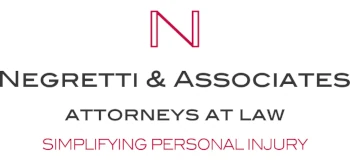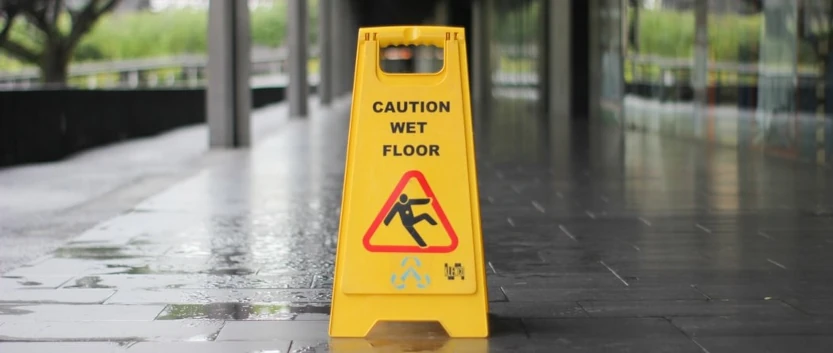In this Legal Beagle podcast, Jonathan Negretti explains what his law firm charges to represent clients. He goes on to illustrate what a client might receive in recovery — whether the case goes to trial or is resolved prior to trial. Further, he explains how his firm strives to simplify personal injury claims for its clients.
This is the fourth and final article in a series designed to help new and prospective clients become acquainted with Negretti & Associates. We’d like to offer this “peek behind the curtain” to showcase the inner workings of our firm — how we work and what we believe in.
By Jonathan Negretti
In previous articles of our Get to Know Negretti & Associates series, we talked about our core values, our staff’s unique personalities and talents, the types of cases that we handle, and the states in which we practice law. This week, I’d like to discuss we charge for representation and what our tagline “Simplifying Personal Injury” means.
Talking about what a law firm charges remains a bit of a taboo in the legal profession. I’m not really sure why. Regardless, I want to explain and be very transparent with you about how our relationship with you, as the client, is structured, and what you would ultimately pay for our representation.
Two Types of Contingency Fees
If you visit our site’s Our Process page, you’ll see an illustration of what we charge and how those numbers break out. We explain this so that you, the client, are fully informed on the representation that you are agreeing to when you sign up with us.
The example we use lists two different types of contingency fees:
- If we can get your case resolved without having to file a lawsuit, then our fee is 33% of that recovery.
- If we have to file a lawsuit then our fee increases to 40% of that recovery.
Why are there two types of contingency fees? Once we file a lawsuit, the rules change, the amount of time changes, and our involvement — in terms of our ongoing participation in the case — changes greatly. To offset that, we increase the contingency fee to our clients.
But remember, our fees are contingent on recovery. In other words, our fees are dependent on our ability to recover something for our clients. It is simply a percentage of the recovery. We receive a percentage of the amounts we recover for our clients.
If we don’t recover anything, we don’t send our clients a bill. Clients don’t see letters from us saying, “Here’s an invoice for all of the hours we spent on your case.”
We offer a sample illustration of how this works, using basic numbers. If we recover $100 for our client, and we do so before a lawsuit is filed, our fee is $33 — one-third of the total recovery. If we were to recover that money after a lawsuit is filed, even if we went all the way to trial, our fee is 40% of that recovery, or $40. The balance that remains is left for the client.
Legal Costs
However, I want to be clear that not all of the remaining balance goes to the client, because our firm must also be reimbursed for legal costs that we incur during the recovery process. Legal costs are what we spend to represent you to get your case in a position where it can resolve fairly for you, the client. Those costs can include ordering a police report, acquiring medical records, doing depositions, and hiring experts — if the case ends up in litigation.
Legal costs can vary greatly depending on the path that your case takes towards resolution. At Negretti & Associates, we don’t mark up our costs. We do not ask for more than what we spend. Further, in an effort to minimize what the client would have to spend out of pocket, we pay those fees on behalf of the client up-front, and ask to be reimbursed when a case concludes.
Let me take the previous illustration one step further. Imagine that our firm spent $5 in legal costs while working on your case, and we got the case resolved before we filed a lawsuit. Our fee would be $33, and an additional $5 atop that. Our firm would receive $38, leaving $62 for the client, right?
Again, in an effort to be completely transparent, not all of the remaining $62 goes to the client. Medical providers may be owed reimbursement, as well. Health insurance may have interest in the recovery. Point is, there may be other parties that need to be paid from the total recovery. In effect, the client may not receive that full $62 difference, after our fee and legal costs.
So, sticking with this same illustration, let’s say that the client owes a medical provider $10. Now, $48 of the total goes to the law firm, to compensate the law firm for legal costs it advanced, as well as $10 to a medical doctor who provided treatment. This means client gets the remaining $52.
To summarize:
- $100 in recovery
- – $33, which goes to the law firm for its work
- – $ 5, which goes to the law firm for legal costs
- – $10, which goes to the medical provider who provided treatment to the client
- Balance: $52
The balance is what is remitted to the client as their part of the case’s settlement proceeds.
Ask Yourself “What Will My Recovery Be?”
Before settling a case, before signing anything from your law firm — ours included — I encourage you to ask, “What will my net recovery be?”
Net recovery is an important term. It simply means what you are going to put in your pocket when a case reaches its conclusion. This doesn’t need to be explained in fancy terms. It’s simply, “What do I get? What is my in-pocket amount? What am I going to walk away from this case with?”
It sounds nice when an attorney says, “Look, I got you a $100,000.” You might say, “Great! How much am I going to get?” But the attorney would say, “You get $2,000.” This just means that $98,000 went to everybody else! This doesn’t seem like a fair deal! However, if you were to get $20,000, and you were able to keep maybe $10,000 or $12,000 of that, this seems like a much better deal.
Make sure that you ask the law firm that represents you — and I say this with ours in mind, as well — to “show me the breakdown.” At Negretti & Associates, we aim to be transparent. For this reason, we provide a settlement breakdown for every single case we handle. We show our clients exactly what they are going to receive, what we are going to receive, what doctors are going to receive, and what might be due to a health insurance company or other third party that’s owed money. We openly share this with our clients.
What’s more, we make sure our clients have all their questions answered before they sign anything, so that they are not left wondering why everyone else is paid so much, while they did not receive as much.
We do our best to try to be fair to our clients on the back end through our representation. If we can reduce medical outstanding bills or liens — those are what providers would hold in case they treated the client without receiving any compensation — we try to reduce those outstanding monies owed, so that the client does receive a fair in-pocket amount.
We’re not in the business of taking a case simply so that we get paid, so that doctors get paid, and the client gets nothing. We remember that the client is the injured party — the reason that the whole case started in the first place. The client should be fairly compensated for what happened.
If a lawsuit is filed, and our firm’s contingency fee percentage rises to 40%, the same breakdown applies:
- $100 in recovery, after lawsuit
- – $40, which goes to the law firm for its work
- – $ 5, which goes to the law firm for legal costs
- – $10, which goes to the medical provider who provided treatment to the client
- Balance: $45. This is what is remitted to the client as their part of the case’s settlement proceeds.
Keep in mind that our fees and costs are two different things, and they are broken out. Our fees change based on where a case is at — whether it can be settled in prelitigation (before a lawsuit), or if it is resolved after a lawsuit is filed. We share this information to be transparent with our clients, so that they can have a good understanding of how our relationship works.
Before even signing up with us, talk to an attorney at our firm — whether it’s me or one of the other very capable attorneys at our firm. As us about how this works. Make sure you understand the terms of our representation, and ensure that your questions are answered, so there aren’t any surprises at the end.
Simplifying Personal Injury
Now, I’d like to switch gears and talk about our firm’s tag line, of “simplifying personal injury.” We adopted this tag line because I think attorneys in general overcomplicate the practice of law. There really isn’t a reason to overcomplicate the practice of law.
At Negretti & Associates, we try to use terms and explanations that make sense to everyone, without having to sound smarter than we really are.
Here’s an example: You may have heard, or may be aware of, a term called a statute of limitations. This simply means the deadline by which you have to file your lawsuit. Otherwise, if you don’t file your lawsuit within a window of time — in most personal injury cases, it’s two years — you lose the right to bring your claim.
The statute of limitations depends on where you the injury occurs and the type of case that you have. The statute of limitations for a dog bite case may be one year, depending on the state where the bite occurred. It’s important that you understand this deadline. If you don’t file your lawsuit to preserve your right to bring that claim — meaning you’re not protecting yourself — then you could lose the ability to bring that claim, and then there would be no recovery.
To keep things simple, we just use the word deadline when we’re talking about a statute of limitations. We understand the legal term statute of limitations, and that’s what the law says we have to abide by, but ultimately, we’re talking about a deadline. You have to file a lawsuit within a certain amount of time.
In law, we often use terms like prelitigation and litigation. But what does litigation mean? It refers to when you file a lawsuit — when you start the process of bringing a claim and involving the courts or a third party, such as arbitration. There are cases where we file an arbitration case — and it’s very similar to a lawsuit, but the process is a little bit different.
When you file a claim, you file a lawsuit. You’re now formally making it known that this is the position of your case, and you’re changing the way that it’s structured. Most of the time, once you do that, you involve a law firm on the other side. By contrast, before you file a lawsuit, you are usually just working with an insurance company, trying to get the case resolved through their claims adjustment process.
So, when I say that we are simplifying personal injury law, what I mean is that we are trying to explain things in a way that makes sense. This is why we explain our fees and costs on our web site in a very basic form, so that we are not using numbers that people can’t comprehend, or that people don’t understand. We try to talk like human beings.
When you hire us, you’ll find that we are different than the old-school law firms with imposing mahogany bookshelves and over-the-top chandeliers in their lobbies. That’s not who we are, because I think that’s not what people care about. I think people really care about connecting with the person representing them. I think they care that the person representing them actually cares about them.
People want to understand what is being explained to them. I don’t pretend to be an expert at finance, but when I talk to financial advisors, I want them to explain things in a way that I understand. I don’t want to shake my head because they are using big terms. I don’t want to be afraid to raise my hand and ask questions, because I’m afraid they are going to think less of me. I want to be able to say, “Look, I don’t understand what you are saying right now. Explain this to me in a way I can understand.” We try to do that every step of the way at Negretti & Associates, and that’s what we mean by simplifying personal injury.
We try to make the process of working with us simple, so that you understand things, and that you are fully informed as we progress. We try not to make it a challenge for you to be represented. You have enough challenges in facing the situation that caused the injury and receiving treatment from doctors and medical professionals. The last thing you want is a complicated process in the legal representation that you chose to engage in, to get your case resolved. We try to make it simple for you, the client, so that your process is straightforward and makes sense. At the end of the day, you should receive what we call fair compensation for what happened to you.
Throughout this Getting to Know Negretti & Associates series of articles, I hope that we’ve done a decent job of opening the curtain and showing you a little bit more about our law firm, why we do the work that we do, how we do the work that we do, and the people who do the work that we do.
If you have any questions about this don’t hesitate to call us. For a free consultation with our legal team, contact us online, call us at 1-833-827-3535, or send us a text. We don’t shy away from picking up the phone and having conversations. There are no dumb questions, and we really mean that! You shouldn’t feel silly asking questions about the representation or about where your case is headed or about why is this happening versus this? Don’t be afraid to ask us questions when we are representing you.






